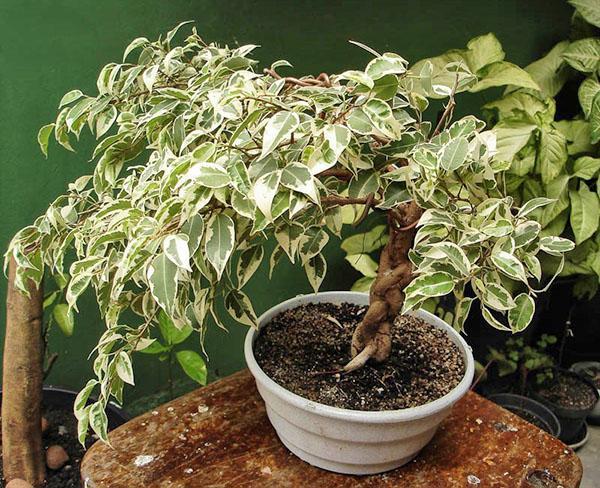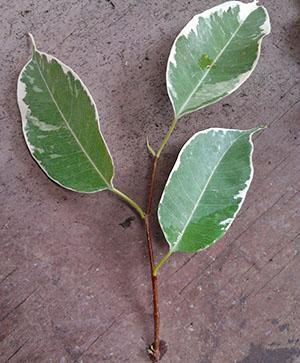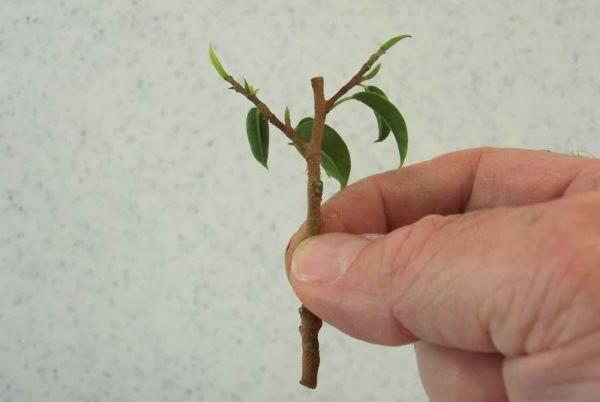Reproduction of ficus Benjamin at home
 Among the relatives, Benjamin's ficus stands out for its medium-sized graceful foliage and a spreading crown. With the advent of new varieties of the plant, its popularity is growing, and for many flower growers the question becomes urgent: "How to reproduce Benjamin's ficus?"
Among the relatives, Benjamin's ficus stands out for its medium-sized graceful foliage and a spreading crown. With the advent of new varieties of the plant, its popularity is growing, and for many flower growers the question becomes urgent: "How to reproduce Benjamin's ficus?"
All ficuses are hardy and very tenacious. Their shoots, in contact with the soil, form roots and give life to new plants. Aerial roots, going down to the ground, provide additional nutrition for the growing crown. Even the unusual shape of the fruit seems to be designed so that the birds eating the flesh will gnaw and then settle the seeds.
But how to propagate Benjamin's ficus at home? Are there any peculiarities and pitfalls here? Plants of this species reproduce vegetatively without complications. The most common method is cuttings, which is how most plants are propagated. Among them are hibiscus, lemon.
On this topic:ficus benjamina home care photo!
Propagation of ficus Benjamin cuttings
To obtain young ficuses it is not at all necessary to take only the apical parts of the shoots. The plant develops when a stem cuttings are rooted with buds sleeping in the leaf axils.

Cuttings are cut from an adult plant so that:
- the base of the future seedling was semi-lignified, that is, still flexible, but no longer green, like the newly formed shoots;
- the stem had 4 to 6 unfolded leaves.
On the cuts of the stems of all varieties of ficuses, milky juice is released. Before rooting, it is removed under running water or with a soft cloth. The lower leaves that interfere with rooting are cut off:
- Immature, green cuttings are almost impossible to root. From a long stay in water or substrate, they rot and die.
- If the grower has only fragments of adult, lignified branches at his disposal, then there is a chance to get roots.
 How to root Benjamin's ficus in the latter case? The base of the cutting is carefully cut along the stem with a very sharp knife. There may be several such cuts. To prevent the parts of the cutting from touching, a match or a toothpick is laid between them. The original technique allows you to stimulate root formation on ordinary cuttings, and is also used by bonsai lovers to obtain miniature plants of the most bizarre shapes.
How to root Benjamin's ficus in the latter case? The base of the cutting is carefully cut along the stem with a very sharp knife. There may be several such cuts. To prevent the parts of the cutting from touching, a match or a toothpick is laid between them. The original technique allows you to stimulate root formation on ordinary cuttings, and is also used by bonsai lovers to obtain miniature plants of the most bizarre shapes.
 When propagating ficus Benjamin, cuttings are rooted in several ways:
When propagating ficus Benjamin, cuttings are rooted in several ways:
- in water;
- in perlite;
- in a light, loose substrate, for example, consisting of peat, crushed charcoal and sand.
At an air temperature of at least 20 ° C and high humidity, roots will form in 2–4 weeks. To speed up the process, use a room greenhouse or cover the container with cuttings with a bulk bag.
The roots formed during the reproduction of Benjamin's ficus are quite powerful. When they grow a few centimeters. It's time to transfer the seedling to a permanent place of "residence" in the ground.
For young ficus, willingly and quickly growing the root system, take a ready-made aerated, moisture-permeable substrate. Sometimes you make your own potting mix. An example is soil based on leaf and sod land, peat and perlite.In such soil, the ficus will receive proper nutrition and securely anchor.
In the first weeks of acclimatization, the seedlings are covered with a bag, which is removed when the plant produces its first leaves.
 At home, propagation of Benjamin's ficus can be carried out using cuttings with only one leaf and a small section of the stem. The main thing is that there is a healthy viable kidney in the sinus.
At home, propagation of Benjamin's ficus can be carried out using cuttings with only one leaf and a small section of the stem. The main thing is that there is a healthy viable kidney in the sinus.
In this case, the shoot along internodes is cut into separate fragments, which are immediately dried with a napkin and planted in the substrate. The soil should reach the base of the leaf petiole, while the leaf plate itself is carefully rolled up and fixed in the form of a tube. This will prevent the seedling from evaporating too much moisture, precious for the tiny plant.
Propagation of ficus Benjamin by layering
This method is used:
- if the plant is reluctant to give young shoots, but there are already mature lignified shoots in abundance;
- bonsai lovers who want to get a lot of aerial roots from the ficus.
 How to root Benjamin's ficus using air layers? The method is similar to reproduction ficus rubber using layering.
How to root Benjamin's ficus using air layers? The method is similar to reproduction ficus rubber using layering.
On a lignified branch or trunk, without affecting the wood, a ring-shaped bark cut is made. Naked tissue is treated with a growth stimulant and wrapped in wet sphagnum or a soil mixture based on it. From above, the structure is fixed with a film, firmly fixing its edges with tape, wire or thread.
 When the formed roots become visible through the film, they are freed, and the seedling obtained from the shoot is carefully cut off below the root system. In the future, the planting of such a plant is carried out in the traditional way, and the place of the cut on the parent plant is treated with garden pitch or ground coal.
When the formed roots become visible through the film, they are freed, and the seedling obtained from the shoot is carefully cut off below the root system. In the future, the planting of such a plant is carried out in the traditional way, and the place of the cut on the parent plant is treated with garden pitch or ground coal.
 How does Benjamin's ficus reproduce yet? Although seed propagation of a crop at home is practically not used due to its laboriousness, it is indispensable when creating new varieties and hybrids. And to obtain a large number of plants of the same type, for example, for landscaping or commercial use, today they resort to cloning. In this case, industrial reproduction is carried out ficus benjamin photo from fragments of leaf tissue.
How does Benjamin's ficus reproduce yet? Although seed propagation of a crop at home is practically not used due to its laboriousness, it is indispensable when creating new varieties and hybrids. And to obtain a large number of plants of the same type, for example, for landscaping or commercial use, today they resort to cloning. In this case, industrial reproduction is carried out ficus benjamin photo from fragments of leaf tissue.
please tell me What's in a dry land and how they planted watering is also not necessary ???? And when and how to water it ???
Without moisture, the stalk cannot form roots. The earth, the substrate, is first moistened. Then the cutting is planted and covered with a glass cover or transparent bag. This creates a mini greenhouse and ideal conditions for rooting.
ficus Benjamin Didn't understand when to water ??? when planting and in general?
I planted a shoot with formed roots in the ground, new leaves appeared very quickly. All was good. But then he became lethargic, one leaf fell off, and the rest do not make me happy either. I specially bought the land in the store. Watered. What could it be?
Here are how many of my friends have ficuses, all complain about their "leaf fall". In one, even an old and simply huge ficus is almost bald, the leaves only remain on the tops. And they seem to be not particularly capricious, but they really don't like waterlogging, well, drafts too. Maybe your handle also has such a problem, was it filled in by accident? After all, he took root, write, and even began to grow ... I would try to see what is being done in the pot, although I do not want to disturb. Check the soil, look at the roots, replace the soil. You can treat it with a fungicide just in case. By the way, the presence of living creatures in the store substrate may also be an option. Maybe someone bit his roots. Better check anyway.